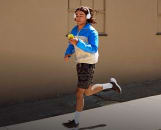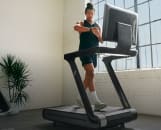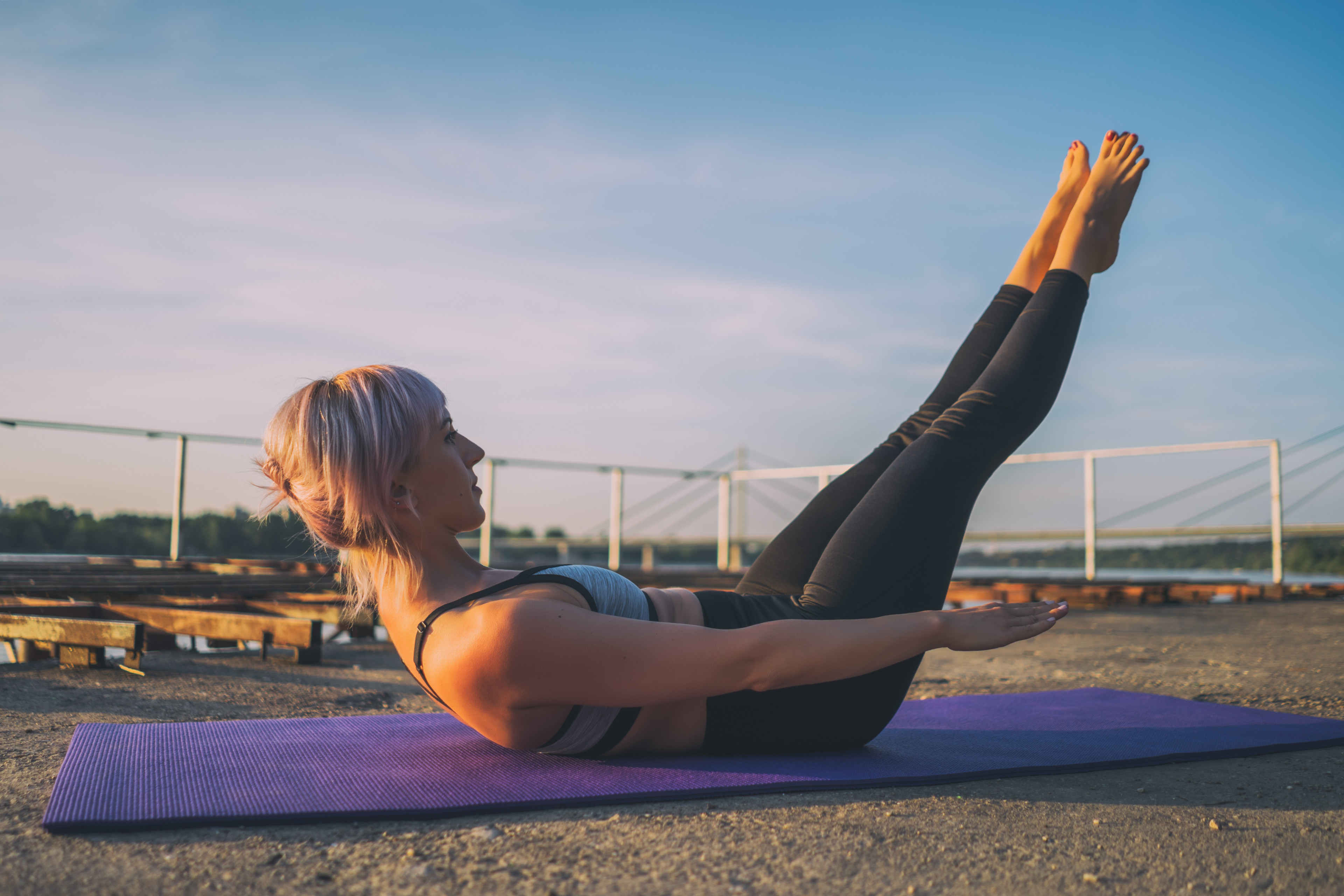
Photodjo/Getty Images
12 Best Beginner Pilates Exercises to Try for a Strong Foundation In Your Practice
Build strength from the inside out with these low-impact exercises.
By Joy Manning•
Pilates exercises have a strong emphasis on precision, form, and control, so it's understandable that they can seem intimidating to beginners. But practicing them comes with unique benefits you don’t get from many other types of workouts. “It’s a way to strengthen yourself from the inside out,” Peloton instructor Kristin McGee says. “I think of it as working in instead of working out.”
The barrier to entry is also relatively low for beginners, as you can get started with little to no equipment. So to help ease you into your Pilates practice, we asked experts to share their knowledge, including tips on how to do 12 beginner-friendly exercises at home.
How to Do Pilates: 12 Exercises for Beginners
There are several forms of Pilates (classical, contemporary, and reformer—to name a few), but mat Pilates is one of the best, most accessible options for beginners looking to do at-home workouts.
“Mat Pilates uses your body weight to build strength,” Anabelen Aranton, a physical therapist and certified Pilates instructor at Texoma Medical Center in Texas says. Its emphasis on proper alignment and deep core activation make it the perfect way to learn and practice Pilates fundamentals. Here are 12 foundational mat exercises to try.

1. Hundreds
This Pilates staple is challenging but accessible for beginners. “There are a lot of ways to make it easier,” Kristin says. “Some people feel a strain in the neck, in which case you can place your head on a yoga block or place one hand behind your head, alternating hands every 10 counts.”
Lie down with your low back pressed gently to the mat. Lift your legs until they’re positioned at a 45-degree angle to the floor. If that’s not possible, bend your knees and elevate your legs until you can keep your low back on the floor.
Curl your head and shoulders off the ground and extend your arms long beside your body. Your palms should face the floor.
Inhale for five counts while you pump your arms up and down. Continue pumping as you exhale for five counts. Repeat this breathing pattern while pumping your arms until you’ve reached 100 counts.
Muscles worked: Deep core muscles, Obliques

2. Roll Up
“This is great because it can prevent the back strains people get from everyday movement. It really focuses on that deeper layer of abdominal muscles,” Kristin says.
Lie on your back and extend your arms overhead on the floor behind you. Your palms should face up.
Lift your arms so they're at a 90-degree angle with the floor and continue to lift your head and shoulders. Slowly peel your spine off the floor with your chin tucked into your chest until you reach a seated position.
Keep your core engaged as you fold forward over your legs and reach for your feet.
Reverse this motion, slowly returning to the floor with control.
Muscles worked: Core muscles, Spine, Hamstrings

3. Single-Leg Circles
“These teach you how to circle your leg independently of letting your hips rock,” Kristin says. Practice keeping your trunk stable during this exercise to engage your deep core. “Imagine you’re using your core to move the leg," she instructs.
Lie on your back with your legs extended and your arms at your sides.
Keeping one leg straight on the floor, lift the other leg toward the ceiling. Slowly make small controlled circles with your lifted leg. Circle five times in one direction, then five times in the opposite direction.
Repeat this movement with the opposite leg.
Muscles worked: Deep core muscles, Hip flexors, Inner and outer thighs

4. Bridge
Bridges are a great way to target your glutes, which help stabilize your hips, legs, core, and low back muscles. As you do them, be sure to keep your pelvis neutral and your core engaged, Aranton says.
Lie on your back and place the bottoms of your feet hip-width distance apart.
Place your arms alongside your body.
Bend your knees to about 90 degrees and make sure your shins are parallel to the floor.
Press into your feet to lift your hips. Hold this position for 30 seconds.
Muscles worked: Deep Core, Hips, and Pelvic Floor

5. Dead Bug
Dead Bug is a straightforward exercise that promotes spine stabilization and strengthens your core. If it feels too challenging, you can modify it by slightly bending your knees or abstaining from lowering your legs too far toward the ground. Looking for more of a challenge? You can also build heat by lifting your head, neck, and shoulders off the floor.
Lie flat on your back. Bring your legs to a tabletop position and lift your arms toward the ceiling so they’re in line with your shoulders.
Inhale as you lower your right arm toward the floor above your head and extend your left leg so it hovers over the ground. Keep your torso firmly planted on the ground.
Exhale as you simultaneously return your right arm and left leg to the starting position. Repeat this movement on the opposite side.
Muscles worked: Core, Hip flexors, and Pelvic floor
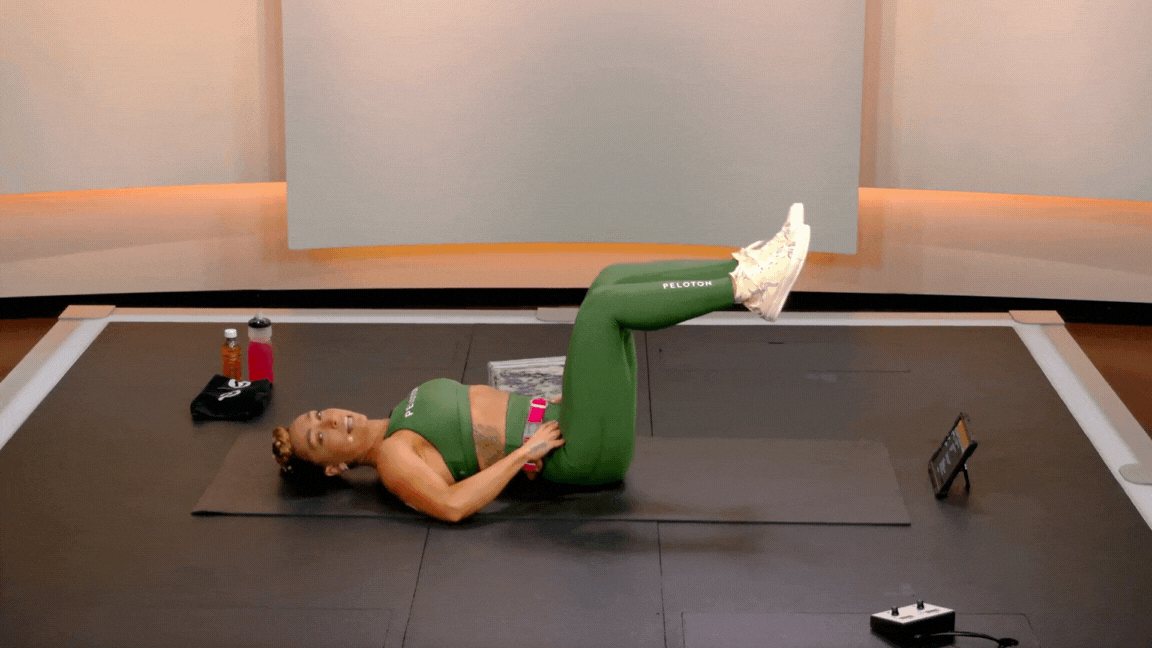
6. Heel Taps
Heel taps are one of the most popular mat Pilates exercises, and this modifiable move is excellent for beginners. If you want to take things up a notch, speed up your movements and elongate your leg farther before tapping your heel.
Lie on your back and bring your legs to a tabletop position.
As you inhale, gently tap your right heel on the ground.
As you exhale, use your abdominal muscles to return your leg to the starting position.
Repeat this movement on the left side.
Muscles stretched: Deep core, Hips

7. Bicycle Crunch
Lie on the floor with your back flat against the ground, taking extra care to keep your lower back pressed down.
Put your elbows out and your hands behind your head. Without straining your neck, lift your head, neck, and shoulders up off the mat.
Bend your knees and bring your legs to a tabletop position. Pull your left knee toward your chest while straightening your right leg.
Twist your body so that your right elbow touches the outside of your left knee, then repeat on the other side, keeping your legs moving in a “bicycle” motion. Take extra care to keep your core engaged and your shoulders lifted off the ground. Repeat 15 times on each side.
Muscles worked: Core, Obliques

8. Double Leg Stretch
Lie face up with your lower back pressed firmly into the ground. Pull both knees in toward your chest while curling your head, neck, and shoulders up.
Gently hold on to the outsides of both of your knees. Extend both legs out to a 45 degree angle, keeping them straight, while simultaneously reaching both arms out overhead.
Then circle both arms out and around while bending your knees until you return to your starting position. Repeat 10-15 times.
Muscles worked: Deep Core (transversus abdominus) and Hip Flexors

9. Pelvic Tilts
Start lying on your back with your knees bent, feet flat on the floor and hip distance apart. Arms are slightly out to your sides with palms flat.
Inhale and let your tailbone fall forward.
As you exhale, pull your belly button in towards your spine, rolling your pelvis back and pressing your back into the floor.
Muscles worked: Lower Back, Core, Glutes, and Pelvic Floor
10. Pelvic Clocks
Start lying on your back with your knees bent, feet planted flat on the floor and hip distance apart. Arms are extended by sides, palms flat.
Draw your belly button towards your spine to tilt your pelvis posteriorly into the 12 o’clock position, then gently let your pelvis drop down in the opposite direction to tilt anteriorly to 6 o’clock.
Keeping your lower core engaged, hike your hip up to the left to come into 3 o’clock, then up to the right to come into 9 o’clock.
Muscles worked: Core, Obliques, Pelvic Floor
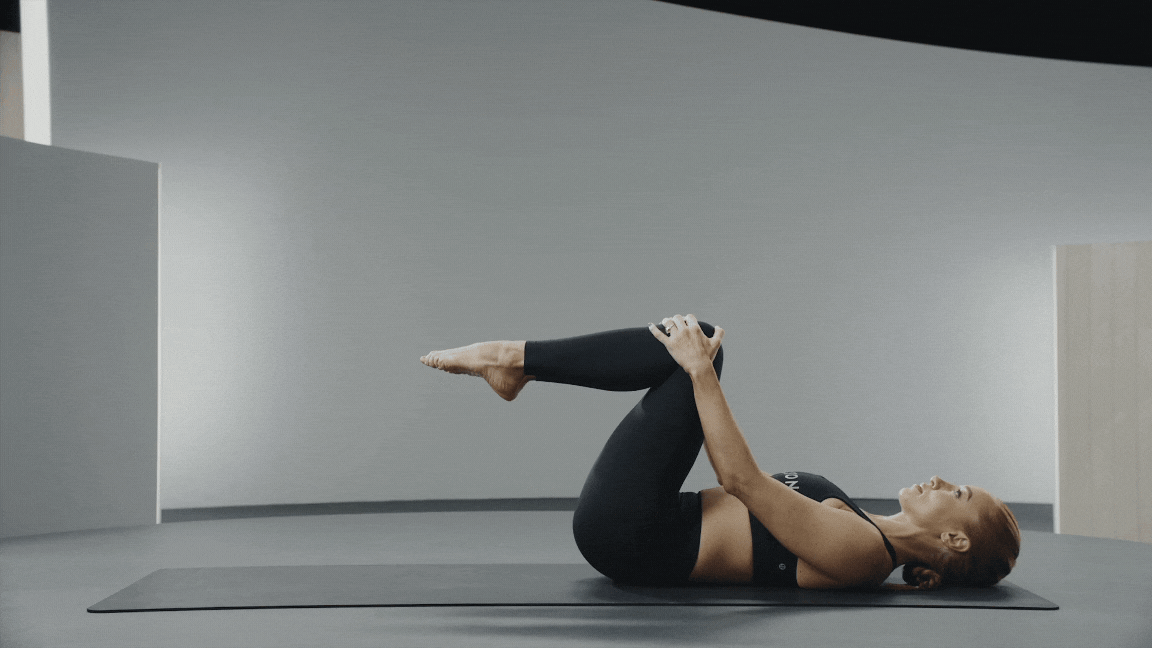
11. Single Leg Stretch
Start on your back with legs in a table top position. Point your toes and place hands on your knees.
Slowly lift your upper body off of the floor, and pull one knee into your chest while extending the opposite leg straight out. Your outside hand can reach for your ankle and the inside hand can support the knee of your bent leg.
Switch legs.
Muscles worked: core muscles and hip flexors

12. Plank
Start in a kneeling position and place your hands on the floor, directly underneath your shoulders.
Extend your legs and feet directly behind you, pressing your toes into the floor.
Keep a neutral spine and press your heels back, while continuing to press your palms into the floor.
Hold.
Muscles worked: Core (especially deep core muscles),Shoulders, Back, Glutes, Quads

Peloton App
Access thousands of classes with no equipment needed.
How to Do Pilates at Home: Try These Simple Routines
An advantage of Pilates is that you can do a full-body or isolated workout even from anywhere. As you begin your exciting journey into Pilates, you can start with simple, easy positions and then build on that foundation with challenging movements and holds. Over time, you may even want to invest in Pilates equipment, so you can start trying more advanced moves like Pilates ball exercises and Pilates ring exercises.
If you want to work out alongside Kristin or another Peloton instructor, there’s a wide variety of Pilates classes available in the Peloton App. Depending on how much time you have, these three are especially great for beginners:
Whether you make Pilates a pillar of your fitness routine or practice it alongside another type of movement, you’ll likely find it’s worth your time and energy. As Kristin says, “Pilates is a hidden gem and very complementary to anything else you do."
This content is for informational and educational purposes only and does not constitute individualized advice. It is not intended to replace professional medical evaluation, diagnosis, or treatment. Seek the advice of your physician for questions you may have regarding your health or a medical condition. If you are having a medical emergency, call your physician or 911 immediately.
Build full-body strength
Enter your email to get articles, instructor tips, and updates from Peloton sent to your inbox.
By providing your email address, you agree to receive marketing communications from Peloton.
For more about how we use your information, see our Privacy Policy.
